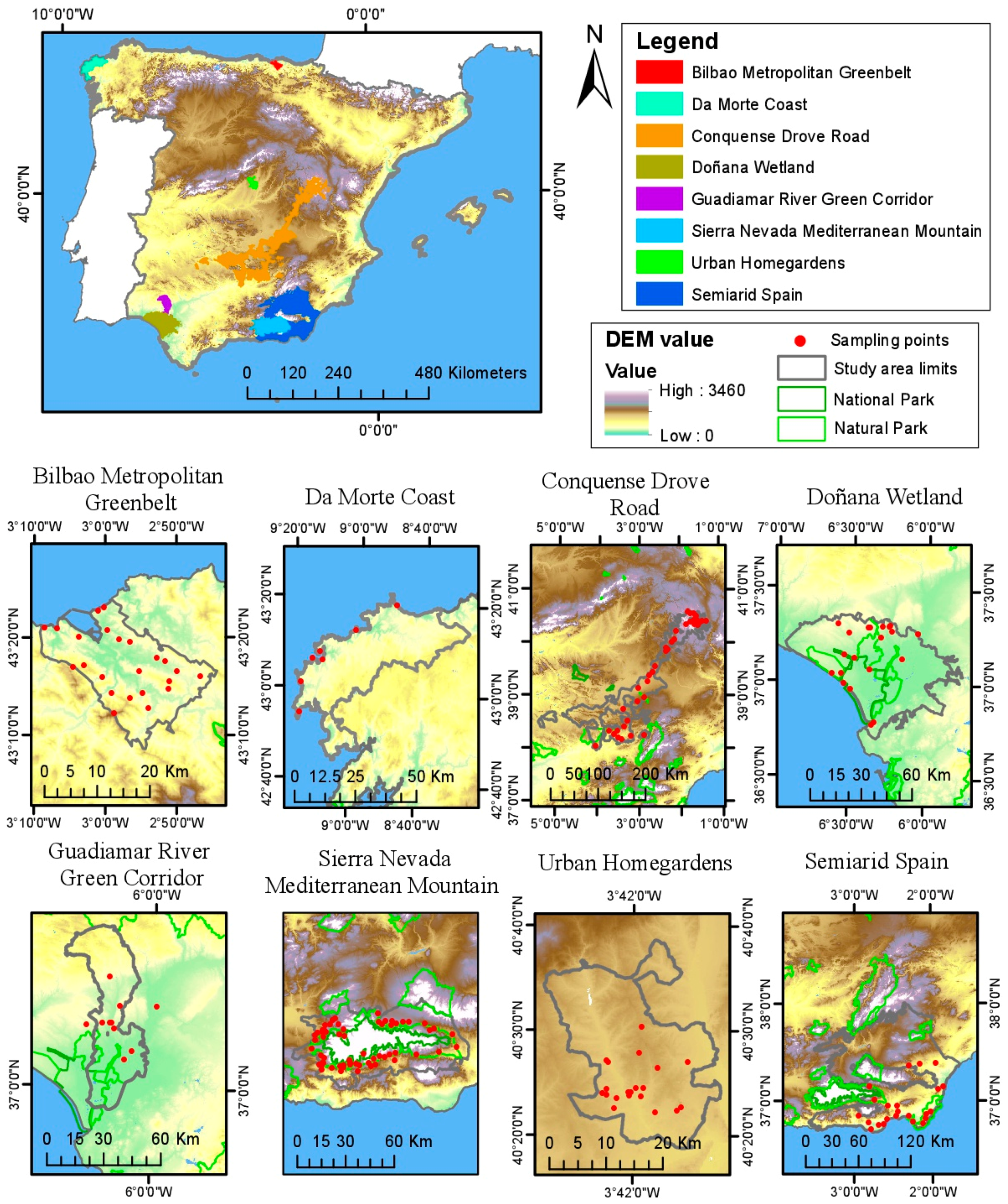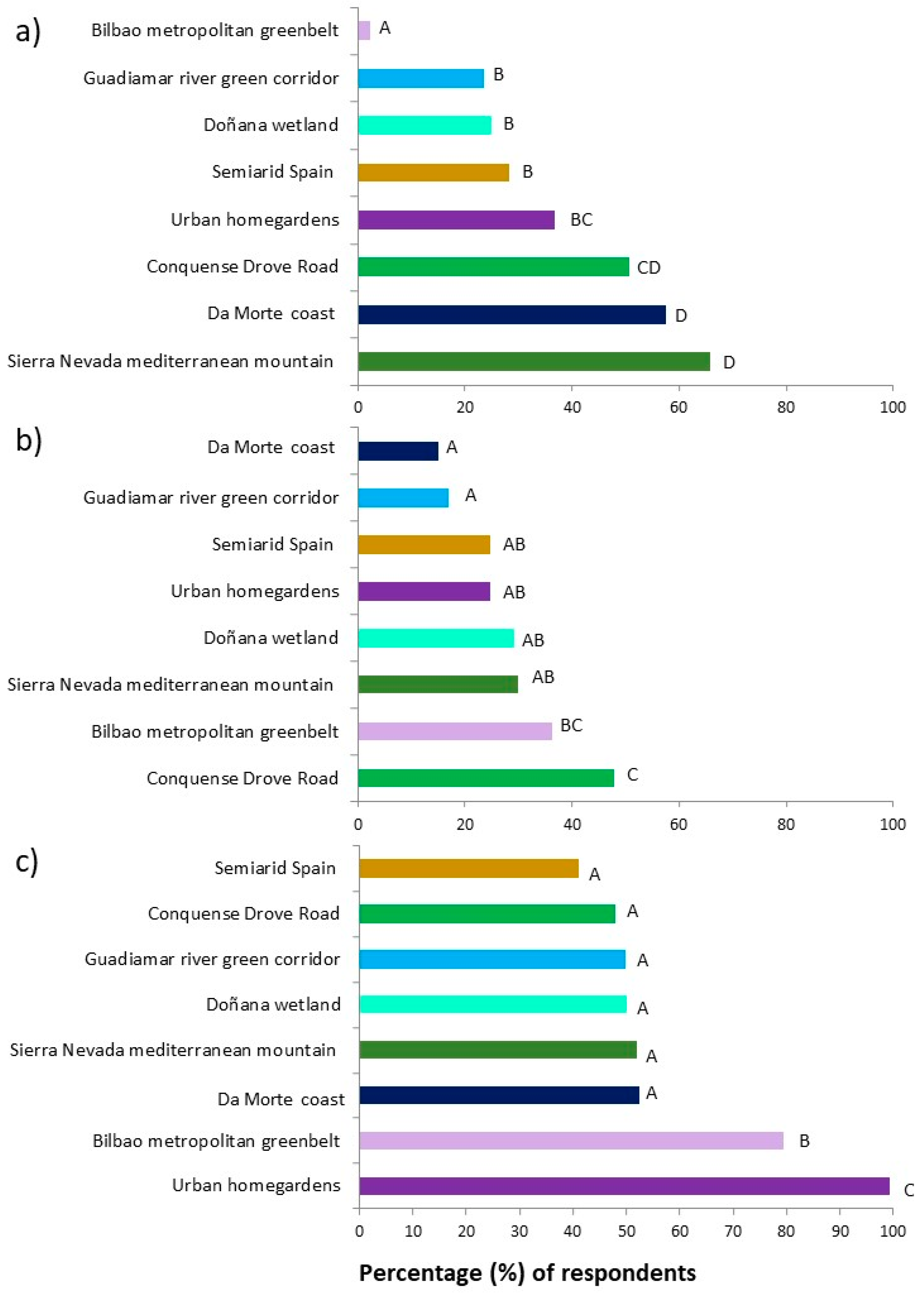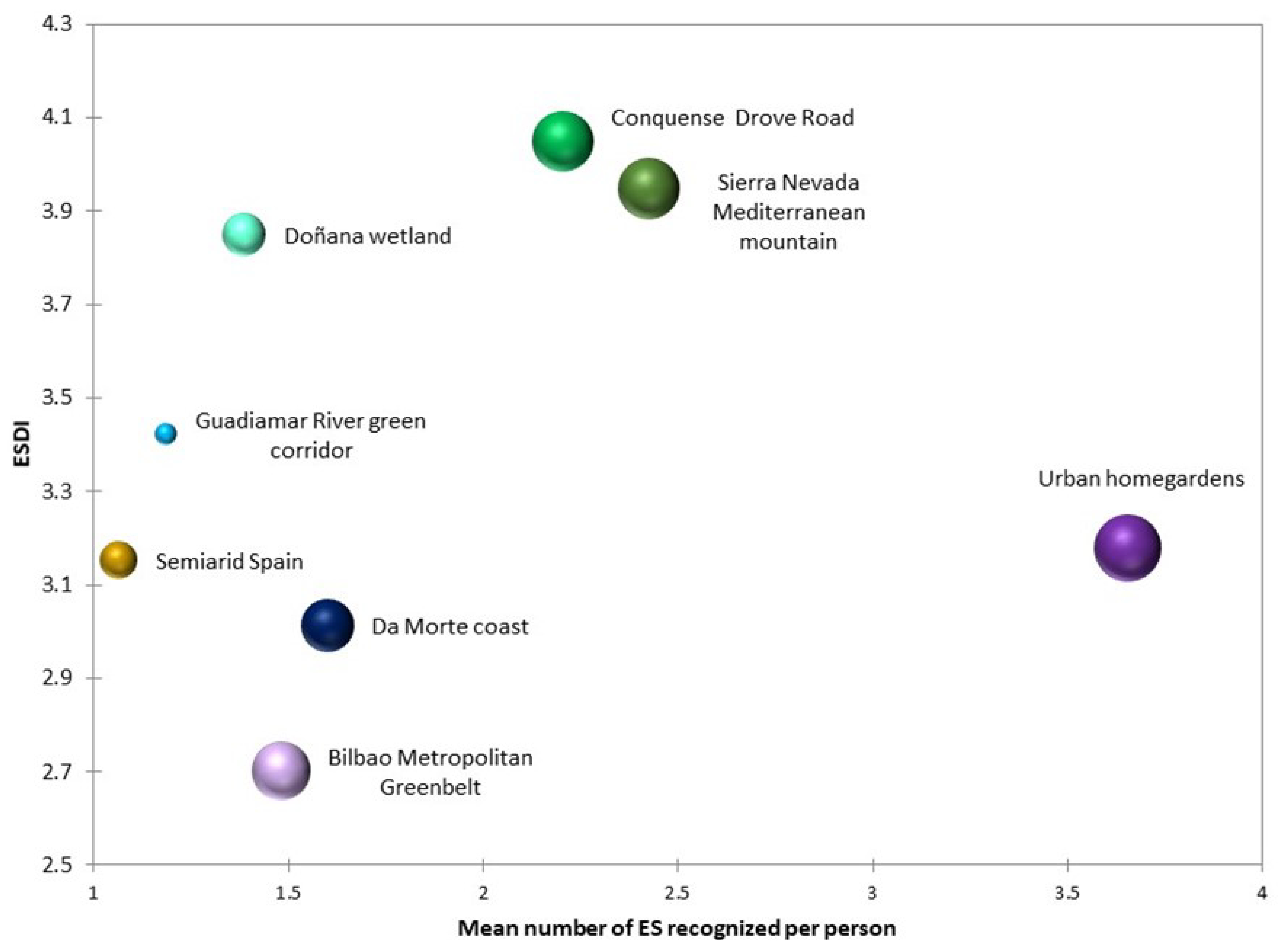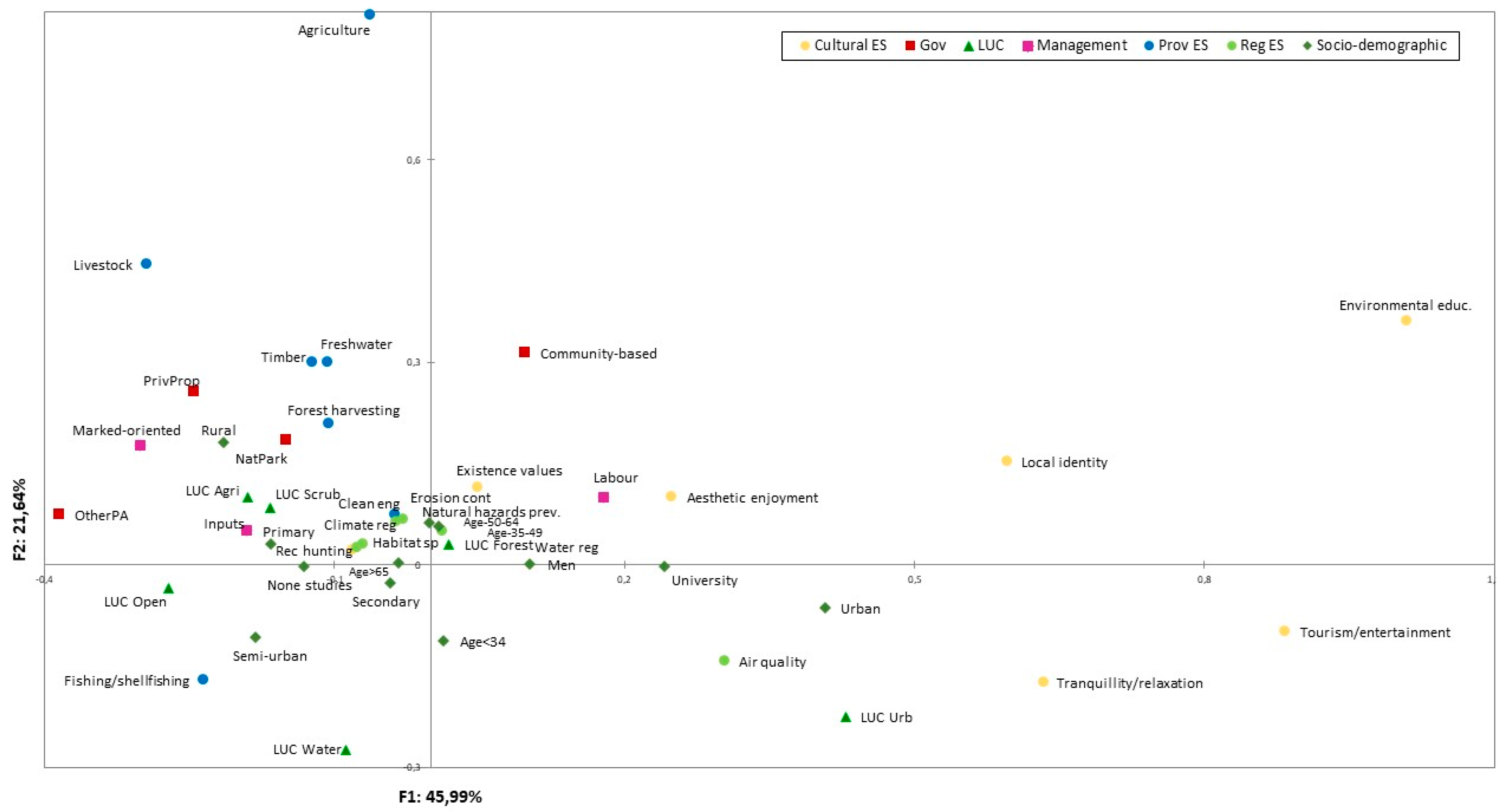Local Perceptions of Ecosystem Services Across Multiple Ecosystem Types in Spain
Abstract
:1. Introduction
2. Materials and Methods
2.1. Study Sites
2.2. Sampling Strategy and Data Collection
2.3. Data Analysis
3. Results
3.1. Perceptions of ES Supply
3.2. Perceptions on ES Diversity
3.3. The Influence of Biophysical, Socio-Demographic and Institutional Variables on the Perception of Ecosystem Capacity to Provide ES across Ecosystem Types
4. Discussion
4.1. Uncovering ES Preferences through the Freelisting Technique
4.2. An ES Diversity Index for Measuring Ecosystem Multifunctionality
4.3. The Influence of Socio-Demographic and Institutional Factors on ES Perceptions
5. Conclusions
Author Contributions
Funding
Acknowledgments
Conflicts of Interest
Appendix A. Description of the Study Sites
Appendix B
| Variable Type | Variable | F1 | F2 | F3 |
|---|---|---|---|---|
| Provisioning ES | Food from agriculture | −0.063 | 0.814 | 0.085 |
| Food from livestock | −0.294 | 0.446 | −0.122 | |
| Fishing and shell fishing | −0.236 | −0.170 | 0.813 | |
| Forest harvesting | −0.106 | 0.210 | −0.065 | |
| Freshwater | −0.123 | 0.300 | −0.087 | |
| Clean energy | −0.037 | 0.074 | 0.013 | |
| Timber | −0.108 | 0.300 | −0.056 | |
| Regulating ES | Climate regulation | −0.070 | 0.032 | −0.016 |
| Habitat for species | −0.077 | 0.026 | −0.043 | |
| Air quality | 0.304 | −0.142 | −0.270 | |
| Water regulation | 0.011 | 0.050 | −0.004 | |
| Erosion control | −0.029 | 0.068 | −0.019 | |
| Natural hazards prevention | −0.036 | 0.065 | −0.013 | |
| Cultural ES | Existence values | 0.048 | 0.116 | 0.021 |
| Tranquillity and relaxation | 0.634 | −0.174 | −0.080 | |
| Environmental education | 1.010 | 0.362 | 0.261 | |
| Recreational hunting | −0.081 | 0.022 | −0.008 | |
| Recreational activities | 0.883 | −0.099 | −0.085 | |
| Aesthetic enjoyment | 0.248 | 0.101 | 0.161 | |
| Local identity | 0.596 | 0.153 | 0.060 | |
| LUC (in Ln) | Agricultural lands | −0.190 | 0.100 | −0.180 |
| Forest | 0.019 | 0.030 | 0.080 | |
| Open lands | −0.271 | −0.035 | 0.191 | |
| Scrublands | −0.166 | 0.085 | −0.100 | |
| Urban | 0.429 | −0.224 | −0.010 | |
| Water | −0.089 | −0.273 | 0.090 | |
| Governance | National park | −0.150 | 0.185 | −0.120 |
| Other protected area | −0.385 | 0.075 | 0.169 | |
| Community-based | 0.097 | 0.314 | 0.240 | |
| Private property | −0.246 | 0.256 | −0.263 | |
| Management | Market oriented | −0.302 | 0.178 | 0.148 |
| Labor oriented | 0.178 | 0.101 | 0.122 | |
| Inputs | −0.190 | 0.051 | 0.169 | |
| Socio-demographic | Age: 34 | 0.013 | −0.113 | 0.039 |
| Age: 35-49 | 0.008 | 0.057 | −0.006 | |
| Age: 50-64 | −0.002 | 0.063 | −0.035 | |
| Age >65 | −0.034 | 0.003 | −0.005 | |
| Gender: Men | 0.102 | 0.001 | −0.013 | |
| Studies-none | −0.132 | −0.002 | 0.082 | |
| Studies-primary | −0.166 | 0.032 | −0.015 | |
| Studies-secondary | −0.042 | −0.026 | −0.011 | |
| Studies-university | 0.241 | −0.002 | −0.008 | |
| Rural origin | −0.215 | 0.181 | 0.021 | |
| Semi-urban origin | −0.182 | −0.106 | 0.030 | |
| Urban origin | 0.407 | −0.063 | −0.053 | |
| Eigenvalue | 0.081 | 0.038 | 0.024 | |
| Constrained inertia (%) | 45.991 | 21.641 | 13.958 | |
| Cumulative % | 45.991 | 67.632 | 81.589 | |
References
- MA (Millennium Ecosystem Assessment). In Ecosystems and Human Well-Being: Biodiversity Synthesis; World Resources Institute: Washington, DC, USA, 2005.
- Guo, Z.; Zhang, L.; Li, Y. Increased Dependence of Humans on Ecosystem Services and Biodiversity. PLoS ONE 2010, 5, e13113. [Google Scholar] [CrossRef] [PubMed]
- IPBES. Summary for Policymakers of the Regional Assessment Report on Biodiversity and Ecosystem Services for Europe and Central Asia of the Intergovernmental Science-Policy Platform on Biodiversity and Ecosystem Services; Fischer, M., Rounsevell, M., Torre-Marin Rando, A., Mader, A., Church, A., Elbakidze, M., Elias, V., Hahn, T., Harrison, P.A., Hauck, J., Eds.; IPBES secretariat: Bonn, Germany, 2018; p. 48. [Google Scholar]
- Chan, K.M.A.; Shaw, M.R.; Cameron, D.R.; Underwood, E.C.; Daily, G.C. Conservation Planning for Ecosystem Services. PLoS Biol. 2006, 4, e379. [Google Scholar] [CrossRef] [PubMed] [Green Version]
- Fisher, B.; Turner, K.; Zylstra, M.; Brouwer, R.; de Groot, R.; Farber, S.; Ferraro, P.; Green, R.; Hadley, D.; Harlow, J.; et al. Ecosystem Services and Economic Theory: Integration for Policy-Relevant Research. Ecol. Appl. 2008, 18, 2050–2067. [Google Scholar] [CrossRef] [PubMed] [Green Version]
- Fisher, B.; Turner, R.K.; Morling, P. Defining and classifying ecosystem services for decision making. Ecol. Econ. 2009, 68, 643–653. [Google Scholar] [CrossRef] [Green Version]
- Lamarque, P.; Quétier, F.; Lavorel, S. The diversity of the ecosystem services concept and its implications for their assessment and management. Comptes Rendus Biol. 2011, 334, 441–449. [Google Scholar] [CrossRef]
- Díaz, S.; Demissew, S.; Carabias, J.; Joly, C.; Lonsdale, M.; Ash, N.; Larigauderie, A.; Adhikari, J.R.; Arico, S.; Báldi, A.; et al. The IPBES Conceptual Framework—Connecting nature and people. Curr. Opin. Environ. Sustain. 2015, 14, 1–16. [Google Scholar] [CrossRef] [Green Version]
- Pascual, U.; Balvanera, P.; Díaz, S.; Pataki, G.; Roth, E.; Stenseke, M.; Watson, R.T.; Başak Dessane, E.; Islar, M.; Kelemen, E.; et al. Valuing nature’s contributions to people: The IPBES approach. Curr. Opin. Environ. Sustain. 2017, 26–27, 7–16. [Google Scholar] [CrossRef] [Green Version]
- Ministerio de Medio Ambiente y Medio Rural y Marino. Plan Estratégico del Patromonio Natural y de la Bdiodiversidad 2011–2017; Ministerio de Medio Ambiente y Medio Rural y Marino: Madrid, Spain, 2011; p. 194. [Google Scholar]
- EUROPARC-ESPAÑA 2016. Programa Sociedad y Áreas Protegidas 2020. Áreas Protegidas Para el Bienestar Humano. Available online: http://www.redeuroparc.org/system/files/shared/Programa_2020/programa2020.pdf (accessed on 16 September 2020).
- Estrategia Estatal de Infraestructura Verde y de la Conectividad y la Restauración Ecológica. (2019-Borrador). Ministerio para la Transición Ecológica. Gobierno de España. Available online: https://www.miteco.gob.es/images/es/borradoreeivcre_infopublica_tcm30-497133.PDF (accessed on 16 September 2020).
- Jacobs, S.; Dendoncker, N.; Martín-López, B.; Barton, D.N.; Gomez-Baggethun, E.; Boeraeve, F.; McGrath, F.L.; Vierikko, K.; Geneletti, D.; Sevecke, K.J.; et al. A new valuation school: Integrating diverse values of nature in resource and land use decisions. Ecosyst. Serv. 2016, 22, 213–220. [Google Scholar] [CrossRef]
- Villegas-Palacio, C.; Berrouet, L.; López, C.; Ruiz, A.; Upegui, A. Lessons from the integrated valuation of ecosystem services in a developing country: Three case studies on ecological, socio-cultural and economic valuation. Ecosyst. Serv. 2016, 22, 297–308. [Google Scholar] [CrossRef]
- Gómez-Baggethun, E.; Martín-López, B. Ecological economics perspectives on ecosystem services valuation. In Handbook of Ecological Economics; Martinez-Alier, J., Muradian, R., Eds.; Edward Elgar: Cheltenham, UK, 2015; pp. 260–282. [Google Scholar]
- Loc, H.H.; Thi Hong Diep, N.; Can, N.T.; Irvine, K.N.; Shimizu, Y. Integrated evaluation of Ecosystem Services in Prawn-Rice rotational crops, Vietnam. Ecosyst. Serv. 2017, 26, 377–387. [Google Scholar] [CrossRef]
- Seppelt, R.; Dormann, C.F.; Eppink, F.V.; Lautenbach, S.; Schmidt, S. A quantitative review of ecosystem service studies: Approaches, shortcomings and the road ahead. J. Appl. Ecol. 2011, 48, 630–636. [Google Scholar] [CrossRef]
- Braat, L.C.; de Groot, R. The ecosystem services agenda: Bridging the worlds of natural science and economics, conservation and development, and public and private policy. Ecosyst. Serv. 2012, 1, 4–15. [Google Scholar] [CrossRef] [Green Version]
- de Groot, R.; Brander, L.; van der Ploeg, S.; Costanza, R.; Bernard, F.; Braat, L.; Christie, M.; Crossman, N.; Ghermandi, A.; Hein, L.; et al. Global estimates of the value of ecosystems and their services in monetary units. Ecosyst. Serv. 2012, 1, 50–61. [Google Scholar] [CrossRef]
- Nieto-Romero, M.; Oteros-Rozas, E.; González, J.A.; Martín-López, B. Exploring the knowledge landscape of ecosystem services assessments in Mediterranean agroecosystems: Insights for future research. Environ. Sci. Policy 2014, 37, 121–133. [Google Scholar] [CrossRef]
- Martín-López, B.; Iniesta-Arandia, I.; García-Llorente, M.; Palomo, I.; Casado-Arzuaga, I.; Amo, D.G.D.; Gómez-Baggethun, E.; Oteros-Rozas, E.; Palacios-Agundez, I.; Willaarts, B.; et al. Uncovering Ecosystem Service Bundles through Social Preferences. PLoS ONE 2012, 7, e38970. [Google Scholar] [CrossRef] [Green Version]
- Iniesta-Arandia, I.; García-Llorente, M.; Aguilera, P.A.; Montes, C.; Martín-López, B. Socio-cultural valuation of ecosystem services: Uncovering the links between values, drivers of change, and human well-being. Ecol. Econ. 2014, 108, 36–48. [Google Scholar] [CrossRef]
- Oteros-Rozas, E.; Martín-López, B.; González, J.A.; Plieninger, T.; López, C.A.; Montes, C. Socio-cultural valuation of ecosystem services in a transhumance social-ecological network. Reg. Environ. Chang. 2014, 14, 1269–1289. [Google Scholar] [CrossRef]
- Sandifer, P.A.; Sutton-Grier, A.E.; Ward, B.P. Exploring connections among nature, biodiversity, ecosystem services, and human health and well-being: Opportunities to enhance health and biodiversity conservation. Ecosyst. Serv. 2015, 12, 1–15. [Google Scholar] [CrossRef] [Green Version]
- Camps-Calvet, M.; Langemeyer, J.; Calvet-Mir, L.; Gómez-Baggethun, E. Ecosystem services provided by urban gardens in Barcelona, Spain: Insights for policy and planning. Environ. Sci. Policy 2016, 62, 14–23. [Google Scholar] [CrossRef]
- Sherrouse, B.C.; Semmens, D.J.; Ancona, Z.H.; Brunner, N.M. Analyzing land-use change scenarios for trade-offs among cultural ecosystem services in the Southern Rocky Mountains. Ecosyst. Serv. 2017, 26, 431–444. [Google Scholar] [CrossRef]
- Swetnam, R.D.; Harrison-Curran, S.K.; Smith, G.R. Quantifying visual landscape quality in rural Wales: A GIS-enabled method for extensive monitoring of a valued cultural ecosystem service. Ecosyst. Serv. 2017, 26, 451–464. [Google Scholar] [CrossRef]
- Russell, R.; Guerry, A.D.; Balvanera, P.; Gould, R.K.; Basurto, X.; Chan, K.M.A.; Klain, S.; Levine, J.; Tam, J. Humans and Nature: How Knowing and Experiencing Nature Affect Well-Being. Annu. Rev. Environ. Resour. 2013, 38, 473–502. [Google Scholar] [CrossRef]
- Norgaard, R.B. Ecosystem services: From eye-opening metaphor to complexity blinder. Ecol. Econ. 2010, 69, 1219–1227. [Google Scholar] [CrossRef]
- Bieling, C.; Plieninger, T.; Pirker, H.; Vogl, C.R. Linkages between landscapes and human well-being: An empirical exploration with short interviews. Ecol. Econ. 2014, 105, 19–30. [Google Scholar] [CrossRef] [Green Version]
- Kelemen, E.; García-Llorente, M.; Pataki, G. Non-monetary techniques for the valuation of ecosystem services. In OpenNESS Reference Book; Potschin, M., Jax, K., Eds.; EC FP7 Grant Agreement No. 308428; Available online: http://www.openness-project.eu/library/reference-book/sp-non-monetary-valuation (accessed on 16 September 2020).
- Scholte, S.S.K.; van Teeffelen, A.J.A.; Verburg, P.H. Integrating socio-cultural perspectives into ecosystem service valuation: A review of concepts and methods. Ecol. Econ. 2015, 114, 67–78. [Google Scholar] [CrossRef]
- Quintas-Soriano, C.; Brandt, J.; Running, K.; Baxter, C.; Gibson, D.; Narducci, J.; Castro, A. Social-ecological systems influence ecosystem service perception: A Programme on Ecosystem Change and Society (PECS) analysis. Ecol. Soc. 2018, 23. [Google Scholar] [CrossRef] [Green Version]
- Castro, A.J.; Quintas-Soriano, C.; Egoh, B.N. Ecosystem services in dryland systems of the world. J. Arid Environ. 2018, 159, 1–3. [Google Scholar] [CrossRef]
- Edwards, D.; Jay, M.; Jensen, F.; Lucas, B.; Marzano, M.; Montagné, C.; Peace, A.; Weiss, G. Public Preferences Across Europe for Different Forest Stand Types as Sites for Recreation. Ecol. Soc. 2012, 17. [Google Scholar] [CrossRef]
- van Zanten, B.T.; Verburg, P.H.; Koetse, M.J.; van Beukering, P.J.H. Preferences for European agrarian landscapes: A meta-analysis of case studies. Landsc. Urban Plan. 2014, 132, 89–101. [Google Scholar] [CrossRef] [Green Version]
- Fagerholm, N.; Torralba, M.; Burgess, P.J.; Plieninger, T. A systematic map of ecosystem services assessments around European agroforestry. Ecol. Indic. 2016, 62, 47–65. [Google Scholar] [CrossRef]
- Torralba, M.; Oteros-Rozas, E.; Moreno, G.; Plieninger, T. Exploring the Role of Management in the Coproduction of Ecosystem Services from Spanish Wooded Rangelands. Rangel. Ecol. Manag. 2018, 71, 549–559. [Google Scholar] [CrossRef]
- Spanish National Ecosystem Assessment. Ecosystems and Biodiversity for Human Wellbeing. Synthesis of the Key Findings; Biodiversity Foundation of the Spanish Ministry of Agriculture, Food and Environment: Madrid, Spain, 2013; p. 90. [Google Scholar]
- Oteros-Rozas, E.; González, J.A.; Martín-López, B.; López, C.A.; Zorrilla-Miras, P.; Montes, C. Evaluating Ecosystem Services in Transhumance Cultural Landscapes An Interdisciplinary and Participatory Framework. GAIA Ecol. Perspect. Sci. Soc. 2012, 21, 185–193. [Google Scholar] [CrossRef]
- García-Llorente, M.; Harrison, P.A.; Berry, P.; Palomo, I.; Gómez-Baggethun, E.; Iniesta-Arandia, I.; Montes, C.; del Amo, D.G.; Martín-López, B. What can conservation strategies learn from the ecosystem services approach? Insights from ecosystem assessments in two Spanish protected areas. Biodivers. Conserv. 2016, 1–23. [Google Scholar] [CrossRef] [Green Version]
- Gómez-Ortiz, A.; Oliva, M.; Salvà-Catarineu, M.; Salvador-Franch, F. The environmental protection of landscapes in the high semiarid Mediterranean mountain of Sierra Nevada National Park (Spain): Historical evolution and future perspectives. Appl. Geogr. 2013, 42, 227–239. [Google Scholar] [CrossRef]
- Serrano, L. The aquatic systems of Doñana (SW Spain): Watersheds and frontiers. Limnetica 2005, 25, 11–32. [Google Scholar]
- Kelemen, E.; Barton, D.; Jacobs, S.; Martín-López, B.; Saarikoski, H.; Termansen, M.; Bela, G.; Braat, L.; Demeyer, R.; García-Llorente, M.; et al. Preliminary Guidelines for Integrated Assessment and Valuation of Ecosystem Services in Specific Policy Contexts EU FP7 OpenNESS Project Deliverable 4.3; European Commission FP7: Bruxelles, Belgium, 2015. [Google Scholar]
- Shannon, C.E. A mathematical theory of communication. Bell Syst. Tech. J. 1948, 27, 379–423. [Google Scholar] [CrossRef] [Green Version]
- Raudsepp-Hearne, C.; Peterson, G.D.; Bennett, E.M. Ecosystem service bundles for analyzing tradeoffs in diverse landscapes. Proc. Natl. Acad. Sci. USA 2010, 107, 5242–5247. [Google Scholar] [CrossRef] [Green Version]
- Klain, S.C.; Satterfield, T.A.; Chan, K.M.A. What matters and why? Ecosystem services and their bundled qualities. Ecol. Econ. 2014, 107, 310–320. [Google Scholar] [CrossRef]
- Gould, R.K.; Klain, S.C.; Ardoin, N.M.; Satterfield, T.; Woodside, U.; Hannahs, N.; Daily, G.C.; Chan, K.M. A protocol for eliciting nonmaterial values through a cultural ecosystem services frame. Conserv. Biol. 2015, 29, 575–586. [Google Scholar] [CrossRef]
- Martín-López, B.; Gómez-Baggethun, E.; García-Llorente, M.; Montes, C. Trade-offs across value-domains in ecosystem services assessment. Ecol. Indic. 2014, 37, 220–228. [Google Scholar] [CrossRef]
- Jacobs, M. Environmental valuation, deliberative democracy and public decision-making institutions. In Valuing Nature Ethics, Economics and the Environment? Foster, J., Ed.; Routledge: Abingdon, UK, 1997; pp. 211–231. ISBN 978-0-415-14875-7. [Google Scholar]
- Vatn, A. Rationality, institutions and environmental policy. Ecol. Econ. 2005, 55, 203–217. [Google Scholar] [CrossRef]
- García-Llorente, M.; Castro, A.J.; Quintas-Soriano, C.; López, I.; Castro, H.; Montes, C.; Martín-López, B. The value of time in biological conservation and supplied ecosystem services: A willingness to give up time exercise. J. Arid Environ. 2016, 124, 13–21. [Google Scholar] [CrossRef]
- Banzhaf, H.S.; Boyd, J. The Architecture and Measurement of an Ecosystem Services Index. Sustainability 2012, 4, 430–461. [Google Scholar] [CrossRef] [Green Version]
- Paruelo, J.M.; Texeira, M.; Staiano, L.; Mastrángelo, M.; Amdan, L.; Gallego, F. An integrative index of Ecosystem Services provision based on remotely sensed data. Ecol. Indic. 2016, 71, 145–154. [Google Scholar] [CrossRef] [Green Version]
- Rodríguez-Loinaz, G.; Alday, J.G.; Onaindia, M. Multiple ecosystem services landscape index: A tool for multifunctional landscapes conservation. J. Environ. Manag. 2015, 147, 152–163. [Google Scholar] [CrossRef]
- Martín-López, B.; Oteros-Rozas, E.; Cohen-Shacham, E.; Santos-Martín, F.; Nieto-Romero, M.; Carvalho-Santos, C.; González, J.A.; García-Llorente, M.; Klass, K.; Geijzendorffer, I.; et al. Ecosystem services supplied by Mediterranean Basin. In Routledge Handbook of Ecosystem Services; Potschin, M., Haines-Young, R., Fish, R., Turner, R., Eds.; Routledge: Abingdon, UK, 2014; pp. 405–414. [Google Scholar]
- Gómez-Baggethun, E.; Mingorría, S.; Reyes-García, V.; Calvet, L.; Montes, C. Traditional Ecological Knowledge Trends in the Transition to a Market Economy: Empirical Study in the Doñana Natural Areas. Conserv. Biol. 2010, 24, 721–729. [Google Scholar] [CrossRef]
- Calvet-Mir, L.; Gómez-Baggethun, E.; Reyes-García, V. Beyond food production: Ecosystem services provided by home gardens. A case study in Vall Fosca, Catalan Pyrenees, Northeastern Spain. Ecol. Econ. 2012, 74, 153–160. [Google Scholar] [CrossRef]
- Camps-Calvet, M.; Langemeyer, J.; Calvet-Mir, L.; Gomez-Baggethun, E.; March, H. Sowing resilience and contestation in times of crises: The case of urban gardening movements in Barcelona. Partecip. Confl. 2015, 8, 417–442. [Google Scholar] [CrossRef]
- Elmqvist, T.; Setälä, H.; Handel, S.; van der Ploeg, S.; Aronson, J.; Blignaut, J.; Gómez-Baggethun, E.; Nowak, D.; Kronenberg, J.; de Groot, R. Benefits of restoring ecosystem services in urban areas. Curr. Opin. Environ. Sustain. 2015, 14, 101–108. [Google Scholar] [CrossRef] [Green Version]
- Simon Rojo, M.; Moratalla, A.Z.; Alonso, N.M.; Jimenez, V.H. Pathways towards the integration of periurban agrarian ecosystems into the spatial planning system. Ecol. Process. 2014, 3, 13. [Google Scholar] [CrossRef] [Green Version]
- Vidal-Abarca, M.R.; Santos-Martín, F.; Martín-López, B.; Sánchez-Montoya, M.M.; Suárez Alonso, M.L. Exploring the Capacity of Water Framework Directive Indices to Assess Ecosystem Services in Fluvial and Riparian Systems: Towards a Second Implementation Phase. Environ. Manag. 2016, 57, 1139–1152. [Google Scholar] [CrossRef] [PubMed]
- Pyle, R.M. The extinction of experience. Horticulture 1978, 56, 64–67. [Google Scholar]
- Miller, J.R. Biodiversity conservation and the extinction of experience. Trends Ecol. Evol. 2005, 20, 430–434. [Google Scholar] [CrossRef] [PubMed]
- Casado-Arzuaga, I.; Madariaga, I.; Onaindia, M. Perception, demand and user contribution to ecosystem services in the Bilbao Metropolitan Greenbelt. J. Environ. Manag. 2013, 129, 33–43. [Google Scholar] [CrossRef]
- Quintas-Soriano, C.; Castro, A.J.; Castro, H.; García-Llorente, M. Impacts of land use change on ecosystem services and implications for human well-being in Spanish drylands. Land Use Policy 2016, 54, 534–548. [Google Scholar] [CrossRef]
- Langemeyer, J.; Camps-Calvet, M.; Calvet-Mir, L.; Barthel, S.; Gómez-Baggethun, E. Stewardship of urban ecosystem services: Understanding the value(s) of urban gardens in Barcelona. Lands. Urban Plan. 2018, 170, 79–89. [Google Scholar] [CrossRef] [Green Version]
- Forster Milan Urban Food Policy Pact. Selected Good Practices from Cities. Available online: http://fondazionefeltrinelli.it/schede/ebook-utopie-milan-urban-food-policy-pact/ (accessed on 22 July 2020).
- Opdam, P.; Albert, C.; Fürst, C.; Grêt-Regamey, A.; Kleemann, J.; Parker, D.; Rosa, D.L.; Schmidt, K.; Villamor, G.B.; Walz, A. Ecosystem services for connecting actors–lessons from a symposium. Chang. Adapt. Socio Ecol. Syst. 2015, 1. [Google Scholar] [CrossRef]
- Daily, G.C.; Polasky, S.; Goldstein, J.; Kareiva, P.M.; Mooney, H.A.; Pejchar, L.; Ricketts, T.H.; Salzman, J.; Shallenberger, R. Ecosystem services in decision making: Time to deliver. Front. Ecol. Environ. 2009, 7, 21–28. [Google Scholar] [CrossRef] [Green Version]
- Tengberg, A.; Fredholm, S.; Eliasson, I.; Knez, I.; Saltzman, K.; Wetterberg, O. Cultural ecosystem services provided by landscapes: Assessment of heritage values and identity. Ecosyst. Serv. 2012, 2, 14–26. [Google Scholar] [CrossRef]
- Armas, C.; Miranda, J.D.; Padilla, F.M.; Pugnaire, F.I. Special issue: The Iberian Southeast. J. Arid Environ. 2011, 75, 1241–1243. [Google Scholar] [CrossRef]
- Zorrilla-Miras, P.; Palomo, I.; Gómez-Baggethun, E.; Martín-López, B.; Lomas, P.L.; Montes, C. Effects of land-use change on wetland ecosystem services: A case study in the Doñana marshes (SW Spain). Landsc. Urban Plan. 2014, 122, 160–174. [Google Scholar] [CrossRef]
- Gómez-Baggethun, E.; Reyes-García, V.; Olsson, P.; Montes, C. Traditional ecological knowledge and community resilience to environmental extremes: A case study in Doñana, SW Spain. Glob. Environ. Chang. 2012, 22, 640–650. [Google Scholar] [CrossRef]
- Alonso, N.M.; de Casadevante, J.L.F. A desalambrar. Agricultura urbana, huertos comunitarios y regulación urbanística. Hábitat Soc. 2014, 7. [Google Scholar] [CrossRef]




| Characteristics of the Case Study | Data Sampling Characteristics | ||||||||
|---|---|---|---|---|---|---|---|---|---|
| Site | Total area | Main Ecosystems | Land Use Covers | Level of Protection | N° of Muni | Pop Density | Sampling Points | Date | Sample Size (N) |
| Bilbao Metropolitan Greenbelt | 408 | Urban Forests | 33% urban 24% agriculture 19% scrublands 18% forest | None | 29 | 2281.85 | 23 | May 2009/July 2010 | 409 |
| Da Morte coast | 1606 | Coastal Agroecosystems | 33% forest 28% scrublands 16% agriculture 14% open lands 6% urban | None | 17 | 111.68 | 7 | Sep 2008 | 212 |
| Conquense Drove Road | 15297 | Agroecosystems | 53% agriculture 27% scrublands 14% forest | There are 5 natural parks along its extent | 19 | 47.32 | 39 | Sep 2009/March 2010 | 112 |
| Doñana wetland | 3713 | Wetlands Coastal Rivers and streams Forests | 47% agriculture 17% forest 17% scrublands 9% water 7% urban | National park-1969 Natural park-1980 | 16 | 78.81 | 20 | Oct 2007/March 2009 | 772 |
| Guadiamar River green corridor | 2060 | Rivers and streams Agroecosystems | 63% agriculture 16% urban 10% scrublands 5% forests 5% water | Protected landscape-2003 | 15 | 85.69 | 10 | Oct 2008/March 2009 | 211 |
| Sierra Nevada Mediterranean mountains | 3655 | Mountains Forests Drylands | 36% scrublands 34% agriculture 19% forest | Natural Park-1989 National Park-1999 | 73 | 230.44 | 59 | May 2009/July 2011 | 657 |
| Urban homegardens | 604 | Urban | 56% urban 23% agriculture 11% scrublands 9% forest | None | 12 1 | 5337 | 20 | Dec 2012/May 2013 | 158 |
| Semiarid Spain | 12130 | Drylands | 40% agriculture 32% scrublands 18% urban 6% open lands | Cabo de Gata Natural park-1988 | 160 | 379.18 | 26 | Feb to April 2012 | 304 |
| Ecosystem Type | Provisioning | Regulating | Cultural |
|---|---|---|---|
| Conquense Drove Road | Food from agriculture (31.0) Livestock (29.6) Timber (14.1) | Air quality (16.9) Habitat for species (15.5) Natural hazards prevention (11.3) | Recreational activities (17.6) Aesthetic enjoyment (11.3) Tranquillity and relaxation (11.3) |
| Sierra Nevada Mediterranean mountain | Food from agriculture (41.5) Food from livestock (25.1) Freshwater (20.0) Timber (17.4) Forest harvesting (11.7) | Air quality (16.5) | Recreational activities (32.9) Tranquillity and relaxation (15.0) Aesthetic enjoyment (11.7) |
| Semiarid Spain | Food from agriculture (23.4) | Climate regulation (15.1) | Recreational activities (27.3) Aesthetic enjoyment (13.2) |
| Doñana wetland | Traditional agriculture (13.5) Fishing and shell fishing (10.4) | Habitat for species (16.7) Air quality (11.5) | Recreational activities (27.1) Aesthetic enjoyment (12.5) |
| Guadiamar River green corridor | Food from agriculture (12.8) | Habitat for species (10.0) | Recreational activities (32.7) Aesthetic enjoyment (19.0) |
| Bilbao Metropolitan Greenbelt | Food from agriculture (16.1) | Air quality (31.5) | Recreational activities (25.4) Aesthetic enjoyment (18.1) Tranquillity and relaxation (11.9) |
| Da Morte coast | Fishing and shell fishing (56.5) | - | Recreational activities (47.7) Tranquillity and relaxation (33.7) |
| Urban homegardens | Food from agriculture (36.7) | Air quality (22.2) | Environmental education (81.6) Recreational activities (72.2) Local identity (46.2) Tranquillity and relaxation (36.7) Aesthetic enjoyment (31.0) |
© 2020 by the authors. Licensee MDPI, Basel, Switzerland. This article is an open access article distributed under the terms and conditions of the Creative Commons Attribution (CC BY) license (http://creativecommons.org/licenses/by/4.0/).
Share and Cite
García-Llorente, M.; J. Castro, A.; Quintas-Soriano, C.; Oteros-Rozas, E.; Iniesta-Arandia, I.; González, J.A.; García del Amo, D.; Hernández-Arroyo, M.; Casado-Arzuaga, I.; Palomo, I.; et al. Local Perceptions of Ecosystem Services Across Multiple Ecosystem Types in Spain. Land 2020, 9, 330. https://doi.org/10.3390/land9090330
García-Llorente M, J. Castro A, Quintas-Soriano C, Oteros-Rozas E, Iniesta-Arandia I, González JA, García del Amo D, Hernández-Arroyo M, Casado-Arzuaga I, Palomo I, et al. Local Perceptions of Ecosystem Services Across Multiple Ecosystem Types in Spain. Land. 2020; 9(9):330. https://doi.org/10.3390/land9090330
Chicago/Turabian StyleGarcía-Llorente, Marina, Antonio J. Castro, Cristina Quintas-Soriano, Elisa Oteros-Rozas, Irene Iniesta-Arandia, José A. González, David García del Amo, Marta Hernández-Arroyo, Izaskun Casado-Arzuaga, Ignacio Palomo, and et al. 2020. "Local Perceptions of Ecosystem Services Across Multiple Ecosystem Types in Spain" Land 9, no. 9: 330. https://doi.org/10.3390/land9090330
APA StyleGarcía-Llorente, M., J. Castro, A., Quintas-Soriano, C., Oteros-Rozas, E., Iniesta-Arandia, I., González, J. A., García del Amo, D., Hernández-Arroyo, M., Casado-Arzuaga, I., Palomo, I., Gómez-Baggethun, E., Onaindia, M., Montes, C., & Martín-López, B. (2020). Local Perceptions of Ecosystem Services Across Multiple Ecosystem Types in Spain. Land, 9(9), 330. https://doi.org/10.3390/land9090330





